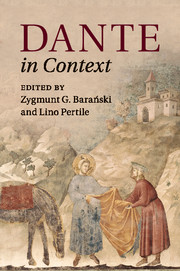Book contents
- Frontmatter
- Dedication
- Contents
- List of illustrations
- List of maps
- Notes on contributors
- Chronology
- Abbreviations and note on translations
- Introduction
- Part I Politics and society
- Part II Intellectual traditions
- Part III Linguistic and literary cultures
- Part IV Visual and performative culture
- Part V Dante: life, works, and reception
- 27 Life
- 28 Works
- 29 Textual transmission
- 30 Early reception (1290–1481)
- Further reading
- Index
29 - Textual transmission
from Part V - Dante: life, works, and reception
Published online by Cambridge University Press: 05 October 2015
- Frontmatter
- Dedication
- Contents
- List of illustrations
- List of maps
- Notes on contributors
- Chronology
- Abbreviations and note on translations
- Introduction
- Part I Politics and society
- Part II Intellectual traditions
- Part III Linguistic and literary cultures
- Part IV Visual and performative culture
- Part V Dante: life, works, and reception
- 27 Life
- 28 Works
- 29 Textual transmission
- 30 Early reception (1290–1481)
- Further reading
- Index
Summary
No manuscript personally penned by Dante has survived. However, we do have a description of his handwriting. In his life of the poet, the Florentine humanist Leonardo Bruni (1370–1444) states that Dante's ‘script was thin and long and very accurate’, as he had been able to ascertain from ‘certain letters written in [the poet's] own hand’. Recently, it has been suggested that the unusual calligraphy for a literary work – in technical terms the hand can be described as a semiformal late mixed gothic bookhand based on chancery cursive – and the two-column layout of many copies of the Commedia from the first half of the fourteenth century might reflect the appearance of the poet's original. The lack of autograph manuscripts means of course that the texts in which we read Dante's works are reconstructions based on the surviving manuscript copies and other textual evidence. Problems – as we shall see – regarding the arrangement and appearance of several works also stem directly from the loss of the authorial versions, as does the question of the formal character, namely the lexis, morphology, orthography, and even syntax, of Dante's written vernacular, since it was normal for scribes to render the texts they were transcribing into the forms of their own Italian vernacular. Thus, while the language of the Commedia is preponderately Florentine, Dante wrote it in exile, spending the last ten years of his life in Verona and Ravenna, so that its earliest copyists were northerners who at times adapted the poem to the structures of their respective speaking habits. In fact, when such northern copies quickly reached Dante's patria, which then became the major centre of production and distribution of the Commedia, Florentine features were reintroduced into the poem (the northern and Tuscan traditions represent the two groups under which all the surviving manuscripts can be included). The likelihood of error and confusion arising at the very start of the tradition as a result of this convoluted transmission is obvious; and, as will soon become apparent, other deficiencies mar the poem's first dissemination. Similar problems affect the form of Dante's Latin. Humanist copyists and editors classicized his medieval Latin, while also finding many of the abbreviations current in the early Trecento difficult to interpret.
- Type
- Chapter
- Information
- Dante in Context , pp. 509 - 517Publisher: Cambridge University PressPrint publication year: 2015



